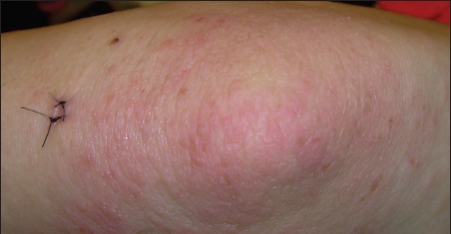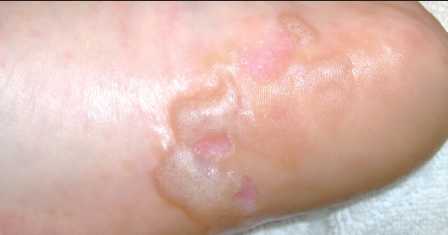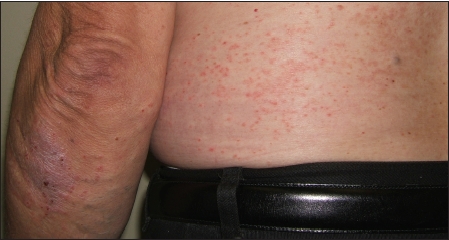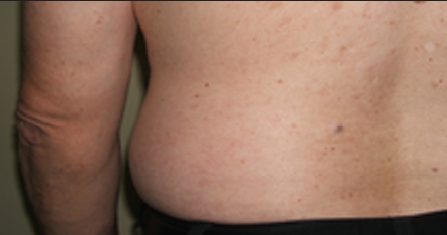Nickel is a very common cause of allergic contact dermatitis (ACD). Sensitized individuals generally have a predictable localized response following cutaneous exposure to nickel, including erythema, vesicles, scaling, and pruritus. Systemic reactions, such as hand dermatitis or generalized eczematous reactions, can occur due to dietary nickel ingestion. This article presents three cases and reviews the evidence regarding this phenomenon.
Case Reports
Case 1. A 37-year-old woman presented with a three-year history of a generalized, extremely pruritic, eczematous dermatitis. She had no history of atopic dermatitis or an atopic diathesis. She had required numerous intramuscular triamcinolone injections and courses of prednisone to relieve the extreme pruritus. Comprehensive patch testing with a modified North American Contact Dermatitis panel was undertaken and revealed only an allergy to nickel. There was no history of localized reactions to metal items, but the patient did relate that around the time of the dermatitis onset, she had purposefully increased her intake of whole wheat products. She was placed on a low nickel diet and her dermatitis subsequently cleared and has remained clear for several years.
Case 2. A 23-year-old woman presented with a third episode of acute onset, extremely pruritic, large blisters of the hands and feet, along with erythematous papules and plaques on the extensor elbows (Figures 1a and 1b). The first episode had occurred at age 12 and the second episode had occurred at age 17. On patch testing, reactions to nickel and cobalt were noted. On further history, she related that in the weeks prior to onset she had been eating soy beans on a daily basis. She was placed on a low nickel diet and the eruption subsequently cleared.
Figure 1a.

Elbow of patient described in Case 2 with pruritic blisters on hands and feet and eruption on elbows due to high dietary nickel consumption
Figure 1b.

Sole of patient described in Case 2 with pruritic blisters on hands and feet and eruption on elbows due to high dietary nickel consumption
Case 3. A 63-year-old man presented with a several year history of an intensely pruritic eruption of red papules affecting the trunk and extremities. The extensor elbows were prominently involved (Figure 2a). Biopsies had been consistent with “a reaction to an internal antigen.” Patch testing revealed only a reaction to nickel. A low nickel diet was implemented and the eruption subsequently cleared by the time of the six-week follow-up visit (Figure 2b).
Figure 2a.

Patient described in Case 3 with generalized eruption involving extensor elbows prior to low nickel diet
Figure 2b.

Patient described in Case 3 with generalized eruption involving extensor elbows six weeks after instituting low nickel diet
Evidence that Dietary Nickel Causes Dermatitis
Dermatitis resulting from dietary nickel has been demonstrated in multiple studies. Jensen et al showed dose-dependent relationships between the amount of nickel ingested and the probability of a dermatitis flare and between the amount ingested and the severity of flares. Doses of 0.3mg, 1mg, and 4mg of nickel sulfate hexahydrate produced cutaneous reactions in 40, 40, and 70 percent of nickel-sensitive participants, respectively. Sixty percent of the participants receiving 4mg of nickel sulfate hexahydrate had widespread cutaneous reactions; whereas, the rate in the placebo group was zero percent.1
A study by Santucci et al provides additional evidence that sudden large doses of dietary nickel can elicit cutaneous flare-ups, but also suggests that nickel-allergic patients may be able to adapt to gradual increases in dietary nickel. Twenty-two of 25 (88%) nickel-allergic patients had cutaneous reactions to a nickel sulfate (NiSO4) 10mg oral challenge at the beginning of the study. However, with a gradual increase in oral dose of NiSO4 (3mg for 1 month, 6mg for 1 month, 10mg for 1 month), only 3 out of 25 patients had to withdraw from the study due to worsening symptoms. Of the 25 patients, 14 had no associated flare-up at all with the gradually increasing doses.2 This study suggests that in some patients, tolerance to increasing nickel in the diet may be achieved if exposure is gradually increased.
Other studies have focused specifically on hand dermatitis in relation to ingested nickel. Menné et al correlated dishydrotic eczema flares with increased levels of urinary nickel. They postulated that increased urine levels were related to boluses of dietary nickel.3 While urinary nickel was measured in this study, dietary nickel is primarily eliminated in the feces, and a measurable amount is also excreted in sweat. Nielsen et al also demonstrated flares of hand eczema with high nickel intake in 10 out of 12 patients.4 It has also been shown that a low nickel diet coupled with a nickel chelator (disulfiram) led to healing of hand eczema in 10 out of 11 nickel-allergic patients.5
Case reports and studies have also linked clinical improvement of eczema in nickel-sensitized individuals with adherence to a low-nickel diet.6,7,8 Veien et al showed clinical improvement of dermatitis in 58 out of 90 nickel-sensitive patients in the short term (4 weeks) with a low nickel diet.7 Follow-up questionnaires demonstrated that 40 out of 55 respondents had long-term improvement from continuing the low-nickel diet. Disulfiram, a nickel chelator, has also been shown to be both an effective initial adjunct to a low nickel diet in clearing persistent dermatitis and an effective monotherapy5,9 in placebo-controlled trials.
Clinical Findings Suggestive of Dietary Nickel-induced Dermatitis
There are two primary situations in which dietary nickel should be considered as a possible cause or exacerbating factor of dermatitis. The best known situation is vesicular hand dermatitis in which there is a positive patch test reaction to nickel.3–5
The second, less known situation, is that of a widespread dermatitis or even isolated pruritus in the setting of a positive nickel patch test. Dietary nickel reactions should be particularly strongly considered when papules on the extensor elbows are noted in patients with widespread dermatitis or hand dermatitis. This relationship between systemic contact dermatitis due to dietary nickel and an eruption on the extensor elbows has been shown to be significant.10 However, since many patients with dermatitis or itching due to dietary nickel do not have this sign, its absence should not dissuade the astute clinician from suspecting the diagnosis of dietary nickel dermatitis.
It should be noted that it has been the lead author’s experience that there is not a correlation between a history of typical nickel contact dermatitis (earring dermatitis or infraumbilical dermatitis) and the likelihood of dietary nickel playing a role in a patient with widespread dermatitis or itch. The lack of a history of typical nickel reactions, in the authors’ opinion, does not rule out nickel as a cause of widespread dermatitis or pruritus.
Possible Mechanism of Dermatitis due to Dietary Nickel
Nickel ingestion causes detectable changes in the immune system that may explain the observed clinical reactions. For example, ingestion of nickel leads to a decrease in circulating CD8+ CD45RO+ CLA+ blood lymphocytes, which correlates with migration of CD8+ memory T cells into tissues. Ingestion of nickel by nickel-sensitive patients has also been shown to increase serum levels of interleukin (IL)-5, a Th2 cytokine, and although contact dermatitis is classically thought of as a type IV hypersensitivity (Th1 reaction), IL-5 is known to enhance proliferation of eosinophils and may explain why eosinophils can be seen on biopsy.11
Dietary Nickel
Individual diets may vary, leading to substantial variability in nickel intake. For example, if an individual consumed the following daily diet: breakfast—a bowl of oatmeal (0.22mg of nickel) and one banana (0.04mg); lunch—one whole grain bun (0.01mg) with a chicken breast (0.01mg), green beans (0.03mg), and a Hershey’s bar (0.01mg); dinner—a serving of broccoli (0.02mg), a baked potato (0.02mg), and a pork chop (0.005mg);snack—a half-cup of peanuts (0.22mg)12; his or her nickel intake for the day would be 0.58mg of nickel, which is well above the amount shown to cause flares.
In addition to the specific foods eaten, a number of other factors can affect the nickel content in the diet. Nickel levels in a given type of fruit or vegetable can vary based on region, water supply, and soil conditions. Nickel can be inadvertently added to processed foods based on the equipment used for processing and can be added to canned foods via leaching from the metallic can.12 Nickel is also present in tap water, especially hot water, which can leach nickel from faucet fixtures into the water sitting overnight in the fixtures.13 Stainless steel cookware is another potential dietary nickel source since cooking acidic foods, such as tomato, vinegar, or lemon in stainless steel cookware has been shown to leach nickel from the cookware into the food.14 The release of nickel from stainless steel cookware was refuted by a French study that cooked foods typical in a French diet, but the foods studied were nonacidic.15
The final, and probably least appreciated, factor in the effects of dietary nickel is absorption of ingested nickel. It has been demonstrated that vitamin C decreases absorption of dietary nickel, as does iron.12,16 Co-ingestion, or lack thereof, of these two nutrients can have a major effect on nickel absorption, even without alteration of the amount of nickel ingestion. Factors such as these highlight how little is understood about the ingestion and metabolism of dietary nickel and the factors that can affect it.
Treatment of Cutaneous Reactions due to Dietary Nickel Ingestion
A low nickel diet has been shown to be effective in multiple studies. This diet is inexpensive, and there are no known significant side effects of the diet. However, the low nickel diet is relatively fiber poor and can lead to constipation in some patients. The authors recommend fiber supplementation for patients who are on this diet. Disulfiram, a nickel chelator, has been shown to be useful as well, but due to the potential for hepatotoxicity in patients taking disulfiram, this medication is probably best reserved for patients with a high suspicion of dietary nickel dermatitis who have failed a low nickel diet. Alternative ways to decrease dietary nickel absorption (and promote fecal excretion) are to recommend addition of iron-rich foods to the diet since iron is a competitive inhibitor of nickel absorption and to recommend vitamin C supplementation, as vitamin C has been shown to reduce the rise in plasma nickel concentration when ingested concurrently with nickel.12,16
In 2007, Sharma proposed nine points important in achieving a low nickel diet. Using Sharma’s points and the available literature as a guide, the authors of this review agree with the following simplified recommendations:12,17 (1) avoid or moderate high nickel foods (Table 1), canned foods, and vitamin supplements/drinks with nickel; (2) eat high vitamin C- and iron-containing foods; (3) run tap water for a few seconds before washing, drinking, or cooking to flush out nickel that may have leached from pipes or fixtures; (4) avoid stainless steel cookware and utensils when cooking acidic foods; (5) consider vitamin C and/or iron supplementation with meals.
Table 1.
Simplified low nickel diet
| Grains | Avoid | Whole wheat bread, multigrain breads, multigrain cereals, wheat bran, wheat germ, whole wheat pasta, oats, oatmeal, buckwheat, seeds |
| Vegetables | Avoid | Beans, lentils, peas, soy beans, soy products (tofu, soy sauce), bean sprouts, brussel sprouts, asparagus, broccoli, cauliflower, spinach, canned vegetables |
| Fruits | Avoid | Canned fruit cocktail, pears, bananas, canned fruits |
| Milk and dairy | Avoid | Chocolate milk |
| Meats | Avoid | Shellfish, processed meats with fillers or coatings, canned meats or fish |
| OTHER SOURCES OF DIETARY NICKEL TO AVOID | ||
| 1. Chocolate and cocoa powder (especially dark chocolate) | ||
| 2. All nuts | ||
| 3. Canned foods in general | ||
| 4. Stainless-steel cooking vessels used for cooking acidic foods | ||
| 5. Vitamins containing nickel | ||
| 6. The first quart of tap water drawn from any faucet in the morning | ||
| 7. Black tea | ||
| 8. All seeds | ||
| 9. Commercial salad dressings | ||
| WAYS TO PREVENT YOUR BODY FROM ABSORBING THE NICKEL YOU DO EAT | ||
| 1. Take a vitamin C supplement with each meal | ||
| 2. Eat a high iron diet | ||
Conclusion
The literature and experience of the authors clearly demonstrate that some nickel-allergic patients have cutaneous reactions when they consume a high nickel diet and that reduction of dietary nickel intake can cause improvement in these patients. Proper dietary modification is harmless and is very inexpensive. For these reasons, recommendation of a low nickel diet should be considered for all patients with either hand dermatitis or a nonspecific, pruritic dermatitis and a positive patch test reaction to nickel.
Contributor Information
Matthew J. Zirwas, Dr. Matthew J. Zirwas is Assistant Professor of Dermatology, The Ohio State University..
Matthew A. Molenda, Dr. Molenda is a Dermatology Resident, The Ohio State University, Columbus, Ohio. The authors report no relevant conflicts of interest..
References
- 1.Jensen CS, Menné T, Lisby S, Kristiansen J, Veien NK. Experimental systemic contact dermatitis from nickel: a dose-response study. Contact Dermatitis. 2003;49(3):124–132. doi: 10.1111/j.0105-1873.2003.00157.x. [DOI] [PubMed] [Google Scholar]
- 2.Santucci B, Cristaudo A, Cannistraci C, Picardo M. Nickel sensitivity: effects of prolonged oral intake of the element. Contact Dermatitis. 1988;19(3):202–205. doi: 10.1111/j.1600-0536.1988.tb02895.x. [DOI] [PubMed] [Google Scholar]
- 3.Menné T, Thorboe A. Nickel dermatitis—nickel excretion. Contact Dermatitis. 1976;2(6):353–354. doi: 10.1111/j.1600-0536.1976.tb03074.x. [DOI] [PubMed] [Google Scholar]
- 4.Nielsen GD, Jepsen LV, Jørgensen PJ, Grandjean P, Brandrup F. Nickel-sensitive patients with vesicular hand eczema: oral challenge with a diet naturally high in nickel. Br J Dermatol. 1990;122(3):299–308. doi: 10.1111/j.1365-2133.1990.tb08277.x. [DOI] [PubMed] [Google Scholar]
- 5.Sharma AD. Disulfiram and low nickel diet in the management of hand eczema: a clinical study. Indian J Dermatol Venereol Leprol. 2006;72(2):113–118. doi: 10.4103/0378-6323.25635. [DOI] [PubMed] [Google Scholar]
- 6.Gawkrodger DJ, Shuttler IL, Delves HT. Nickel dermatitis and diet: clinical improvement and a reduction in blood and urine nickel levels with a low-nickel diet. Acta Derm Venereol. 1988;68(5):453–455. [PubMed] [Google Scholar]
- 7.Veien NK, Hattel T, Laurberg G. Low nickel diet: an open, prospective trial. J Am Acad Dermatol. 1993;29(6):1002–1007. doi: 10.1016/0190-9622(93)70281-w. [DOI] [PubMed] [Google Scholar]
- 8.Veien NK, Hattel T, Justesen O, Nørholm A. Dietary restrictions in the treatment of adult patients with eczema. Contact Dermatitis. 1987;17(4):223–228. doi: 10.1111/j.1600-0536.1987.tb02717.x. [DOI] [PubMed] [Google Scholar]
- 9.Kaaber K, Menné T, Veien N, Hougaard P. Treatment of nickel dermatitis with Antabuse: a double blind study. Contact Dermatitis. 1983;9(4):297–299. doi: 10.1111/j.1600-0536.1983.tb04394.x. [DOI] [PubMed] [Google Scholar]
- 10.Kaaber K, Sjolin KE, Menne T. Elbow Eruptions in nickel and chromate dermatitis. Contact Dermatitis. 1983;9(3):213–216. doi: 10.1111/j.1600-0536.1983.tb04361.x. [DOI] [PubMed] [Google Scholar]
- 11.Jensen CS, Lisby S, Larsen JK, Veien NK, Menné T. Characterization of lymphocyte subpopulations and cytokine profiles in peripheral blood of nickel-sensitive individuals with systemic contact dermatitis after oral nickel exposure. Contact Dermatitis. 2004;50(1):31–38. doi: 10.1111/j.0105-1873.2004.00294.x. [DOI] [PubMed] [Google Scholar]
- 12.Joneja JM. Section III: specific food restrictions: nickel allergy. In: Joneja JM, editor. Managing Food Allergy & Intolerance: A Practical Guide. JA Hall Publications Ltd; 1995. [Google Scholar]
- 13.Andersen KE, Nielsen GD, Flyvholm MA, Fregert S, Gruvberge B. Nickel in tap water. Contact Dermatitis. 1983;9(2):140–143. doi: 10.1111/j.1600-0536.1983.tb04321.x. [DOI] [PubMed] [Google Scholar]
- 14.Kuligowski J, Halperin KM. Stainless steel cookware as a significant source of nickel, chromium, and iron. Arch Environ Contam Toxicol. 1992;23(2):211–215. doi: 10.1007/BF00212277. [DOI] [PubMed] [Google Scholar]
- 15.Accominotti M, Bost M, Haudrechy P, et al. Contribution to chromium and nickel enrichment during cooking of foods in stainless steel utensils. Contact Dermatitis. 1998;38(6):305–310. doi: 10.1111/j.1600-0536.1998.tb05763.x. [DOI] [PubMed] [Google Scholar]
- 16.Solomons NW, Fernando V, Shuler TR, Nielsen FH. Bioavailability of nickel in man: effects of foods and chemically defined dietary constituents on the absorption of inorganic nickel. J Nutr. 1982;112:39–50. doi: 10.1093/jn/112.1.39. [DOI] [PubMed] [Google Scholar]
- 17.Sharma AD. Relationship between nickel allergy and diet. Indian J Dermatol Venereol Leprol. 2007;73:307–312. doi: 10.4103/0378-6323.35733. [DOI] [PubMed] [Google Scholar]


